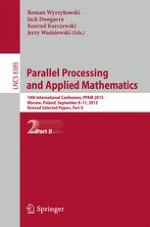This two-volume-set (LNCS 8384 and 8385) constitutes the refereed proceedings of the 10th International Conference of Parallel Processing and Applied Mathematics, PPAM 2013, held in Warsaw, Poland, in September 2013. The 143 revised full papers presented in both volumes were carefully reviewed and selected from numerous submissions. The papers cover important fields of parallel/distributed/cloud computing and applied mathematics, such as numerical algorithms and parallel scientific computing; parallel non-numerical algorithms; tools and environments for parallel/distributed/cloud computing; applications of parallel computing; applied mathematics, evolutionary computing and metaheuristics.
